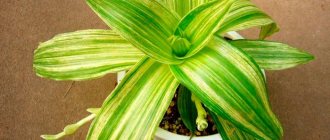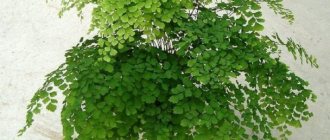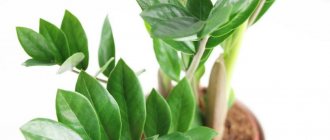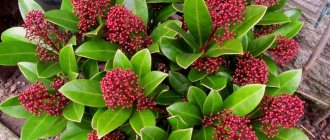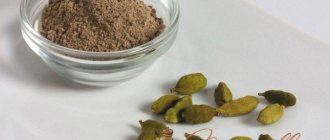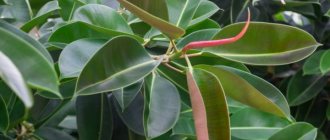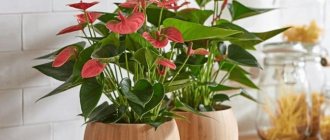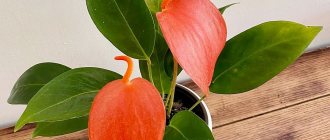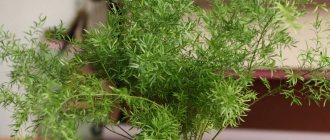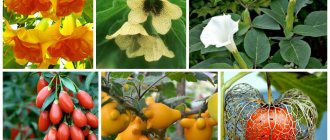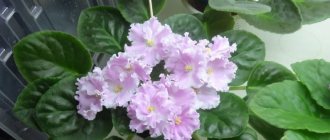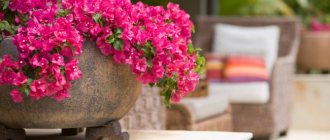The perennial herbaceous evergreen plant Callisia is a member of the Commelinaceae family. In nature, the flower is found in South and Central America, as well as the Antilles, and it prefers to grow in shade and in the high humidity of the subtropics and tropics. The genus consists of 12 species, some of which are cultivated at home. The name “callisia” is derived from two Greek words meaning “beautiful” and “lily”. However, this plant is not closely related to the lily at all, but to Tradescantia.
Brief description of cultivation
- Bloom . At home, callisia flowering is a rather rare occurrence. As a rule, this happens in the last summer or first autumn weeks.
- Illumination . Grows well in light shade or in diffused bright light.
- Temperature regime . In the spring-summer period - from 20 to 24 degrees, and in the cold season - from 16 to 18 degrees. Make sure that the room is not colder than 14 degrees.
- Watering . During the growing season, the bush is watered immediately after the top layer of the substrate has dried. In winter, the soil mixture is moistened only after it has dried to a depth of 1/3.
- Humidity . Requires high air humidity. On hot days, you need to systematically moisten the foliage with a spray bottle.
- Fertilizer . The flower is fed in April–October once every 15 days, using a solution of a mineral complex. In other months, the plant is not fed.
- Rest period . November–March.
- Transplant . While the bush is young, it is replanted regularly once a year, and older specimens are subjected to this procedure less often (once every 2 or 3 years).
- Reproduction . Layering, apical cuttings and dividing the rhizome.
- Diseases . The decorative quality of the plant may suffer due to improper care or unsuitable growing conditions.
- Pests . Spider mites and thrips.
- Properties. The flower reacts extremely negatively to tobacco smoke.
Where is Callisia from?
Homeland of Kallisia
South America is considered, and more precisely, its subtropical and tropical regions. She loves humid places with partial shade. Callisia is also widespread in Mexico and the Antilles.
In the natural range there are about twenty species of Callisia. But in indoor and greenhouse floriculture, several species of this amazing plant are known. We'll talk about them a little below.
Features of care
In order for a flower growing in an apartment or office to be healthy and pleasing with its appearance, it needs to be looked after: watered, fed, loosened the soil, removed damaged stems and dry leaves. The plant is unpretentious to watering, but the soil should not be allowed to dry out, as this will negatively affect growth and development. The soil must be constantly moist. It is important to avoid overwatering, otherwise the stems and roots will begin to rot. Creeping callisia is unpretentious in care, however, it needs regular watering in the summer, in other periods this should be done as needed. In winter, watering is reduced. It is necessary to constantly monitor the soil surface. If it is dry, water it; if it is wet, do not moisten it. If watering is infrequent, the plant withers and the shoots dry out.
The flower is regularly fed with complex flower fertilizer. This must be done monthly, excluding winter. At this time, feeding stops. More frequent feeding is undesirable, as the plant will grow wildly and the stems will weaken.
What does it look like
The plant is decorative, the length of the stem does not exceed 15 cm. The shoot spreads, so it is placed in hanging flowerpots. A more famous type of plant is fragrant callisia, or golden mustache. The creeping variety is a different species.
Callisia creeping
If the first plant has oblong leaves up to 20-30 cm long, the second is distinguished by small heart-shaped elements in two rows on the stem. The front surface is green, the back is lilac-violet. The visible part of the leaf is dotted with small purple dots.
For your information! It blooms extremely rarely indoors, when small white elements appear in the leaf axil on a thin branch.
Callisia grows quickly and in natural conditions covers the ground with a carpet. Prefers rocks and stones, forming garlands on them. Creeping callisia is a species that is not similar in appearance to the golden mustache.
Types and varieties of callisia with photos
Callisia elegant, or graceful (Callisia elegans)
This compact species has creeping and geniculate shoots, their length is more than 50 cm. At first the shoots are upright, but over time they droop down. This flower is very similar in appearance to Tradescantia. Its height can vary from 0.3 to 0.4 m. On the surface of the shoots and foliage there is pubescence that is velvety to the touch. Petiolate-free, oval-shaped foliage has a pointed tip at the top. It reaches a length of about 60 mm, while the back surface is painted in a greenish-violet hue, and the front surface is dark green with silver stripes. White flowers appear at the tops of the stems. Please note that after 2 years the plant loses its decorative effect: the foliage becomes duller and sparse. Restore callisia with layering or cuttings.
Callisia navicularis
This species is quite variable. The fact is that its decorative effect is directly dependent on the growing conditions and variety. In such a succulent plant, the shoots at the nodes take root very quickly. Its succulent, lanceolate-shaped leaf blades are double-rowed, and they are strongly concave and have a longitudinal hollow. The underside of the foliage is violet-brown, and the front surface is greenish-bronze, shimmering red in sunlight. The foliage is devoid of pubescence, but there are short hairs along the line that ascends from the axil. The width of the sheet plates is 15 mm, and the length is 20 mm.
Creeping callisia (Callisia repens)
The bush reaches about 30 centimeters in diameter and up to 20 centimeters in height. The shoots are purple or pale red and rather thin. They are decorated with small, rich green leaf plates covered with purple specks; they are heart-shaped and arranged in 2 rows. The flowers, which are not highly decorative, are painted white. In the garden plot, this species is grown as a ground cover, and in indoor cultivation, the bushes are planted in hanging structures.
Garden forms:
- Bianca . Tender shoots are painted in a purple-reddish hue, while small leaf plates have a rich green color.
- Pink Panther . The foliage of this plant is green-pink, and it is striped.
The following varieties of this species are also popular among gardeners: Noum Popyula, Pink Lady and Tortle.
Fragrant callisia, or Thai (Callisia fragrans)
This species is also popularly called golden mustache, living hair, corn, Far Eastern mustache, and homemade ginseng. This type of callisia differs from others grown at home in that its bush is larger. Its height often reaches about 150 cm. But remember that such a plant needs good support, otherwise it may break under its own weight.
This plant has 2 types of shoots:
- fleshy short vertically growing stems, at the tops decorated with large leaf rosettes;
- tubular long horizontally located processes (articular whiskers), which are necessary for the flower to “conquer” new territories.
The large, leathery leaf blades are quite fragrant and dark green in color. Their width is about 6 centimeters, and their length is up to 30 centimeters. The back surface of the foliage is matte, and the front surface is shiny. If the bush is in a well-lit place, then its foliage takes on a pinkish tint.
Ampelous plant - callisia...
Kinds
The Callisia genus includes 12 species of plants, but the following 5 are suitable for indoor keeping.
Callisia elegans (elegant or graceful callisia).
The height of this variety can reach 40 cm. The shoots have a creeping appearance. The color of the leaves is dark green, their upper part is decorated with white stripes, the lower part is purple. The shape of the leaves is oval, the tips are pointed. The stems and leaves have a fleecy structure. During flowering, white buds grow at the tips of the shoots.
Callisia tehuanttepecana (Tehuantepec).
Resembles an elegant variety, but its leaf blade lacks light stripes. Blooms with bright pink flowers.
Callisia navicularis (scaphoid)
The stems of this species are short, the leaves are green in color, and brownish-purple on the inside. The leaves are boat-shaped, their length is 2 cm, width is 1.5 cm. If the crop is kept under bright sunlight, the leaves become covered with a scarlet tint.
Callisia repens (creeping)
This variety grows up to 10 cm and is characterized by fairly rapid growth. The stems of the crop are thin. This is a small-leaved plant, the length of the leaves is no more than 2 cm. The outer side of the leaf blade is covered with pale purple specks, and a burgundy tint is noticeable on the inside. This is one of the most popular indoor types. The Pink Lady variety is especially in demand among flower growers.
Callisia fragrans (scented or "golden mustache")
The height of the plant can reach 1.5 m. The specimen has erect and horizontal shoots. On erect stems, the leaves grow up to 30 cm in length, their width is 5-6 cm. Horizontal sprouts are tendrils with leaf panicles. This species blooms at the end of winter, however, at home, flowering is a rather rare occurrence. The buds are small, modest, and primitive.
Botanical characteristics
Callisia comes from the genus of the evergreen perennial family Commelineaceae. It is not surprising that the name means “beauty” in Greek. The flower is characterized by creeping and also erect stems, which can form dense thickets. The flower is native to tropical and subtropical regions of the United States.
Callisia creeping
For your information! It is sometimes confused with Tradescantia because they have similar external characteristics.
Today, callisia takes root well at home. The most commonly grown callisia graceful, repens, fragrant and laliform. Fragrant has not only decorative properties, but also medicinal properties. However, do not forget that the plant can cause an allergic reaction in both people and animals.
Callisia repens is characterized by a stem 15-20 cm long, on which spherical, heart-shaped leaves are formed, green on top and burgundy below. They are no more than 3-4 cm in size.
At home, small-leaved callisia blooms rarely, but if the process occurs, the flowers are white and unsightly, although they have a pleasant smell.
Caring for callisia at home
Lighting and location selection
Indoor collision needs a lot of bright light, which should be diffused. Be sure to shade the bush from direct sunlight. If the room is sunny, then the bush can be placed away from the window. It is extremely undesirable to place this plant in the kitchen, because it reacts negatively to various fumes, tobacco smoke, impurities in the air, etc. In order for callisia to feel good, it needs to be provided with regular ventilation of the room, and it can be moved during the warm season to the street or to the balcony.
You can decorate not only your apartment or dacha with callisia; it also feels quite normal in the office. However, special attention must be paid to ventilation. Avoid drafts, as they are even more dangerous for the plant than stuffiness.
Temperature
Callisia feels normal in the summer at temperatures from 20 to 24 degrees, and in winter - from 16 to 20 degrees. But remember that the flower must be protected from cold and sudden temperature changes. Make sure that in winter the room is not colder than 14 degrees.
Watering
In spring and summer, soft water is used to water the collision, the temperature of which should be close to room temperature. The substrate in the pot is moistened immediately after its top layer dries. In autumn and winter, the collision is watered less frequently and sparingly, especially if it is in a cool room. But remember that the soil mixture in the pot should not dry out completely, as this can lead to the death of the bush. Also, make sure that when watering, the liquid does not get into the middle of the leaf rosette, otherwise the plant may rot.
Spraying
Because of its love for high levels of humidity, Callisia repens requires irrigation. If you apply it with a coarse spray, then streaks will remain on the plate. Therefore, it is better to purchase a fine spray nozzle.
Note! From time to time you can arrange a shower for the foliage by placing it under heated running water.
Humidity
The recommended humidity level for the plant coincides with the optimal parameter in a house for people to be in - 60-70%. To achieve this level in temperate latitudes, you need to use a humidifier. To maintain optimal conditions, it is removed from the battery in winter.
Callisia pot
After purchasing a plant from a flower shop, it is not replanted. When the young planting grows slightly, you can replant it. To do this, choose the right container: the pot should be wide, but have a small depth.
It is better to choose a container made of ceramic, but often people buy plastic pots - they are also suitable.
One of the important conditions is the presence of a durable, spacious pallet.
Priming
There are ready-made soil mixtures for tradescantia and callisia on sale, since they belong to the same family. You can prepare the composition yourself. The requirements for the substrate are simple: it must be nutritious, not retain excess moisture, but also not be overly porous. These parameters correspond to a mixture of peat, humus, sand, turf and leaf soil.
Callisia transplant
Feeding
Callisia needs feeding during the active period. A complex fertilizer for tropical flowers is used. Fertilization regime: weekly, from April to October.
Trimming
Like any plant, callisia needs timely pruning when cared for at home. It is better to do this in the spring, when there is abundant growth of shoots. Pruning helps give the bush its traditional shape.
To make the plant more lush, several cuttings are planted in a pot at once. The planting tolerates pruning painlessly.
Where is the best place to place a flower?
If you grow creeping callisia in a bright room, it is not necessary to place it on the windowsill. You can determine a place for the flower in the back of the room, where there is no direct sunlight on the plant. Due to this feature, callisia is often bred for office space.
For better growth and development of the flower, spacious residential or office premises equipped with ventilation, which ensures an influx of fresh air, are best suited. If the room is not ventilated, it is always stuffy and smoky, the flower will not grow, it will die. In summer, it is best to take the pot with the plant outside.
Transfer
Some experts recommend planting a new flower instead of replanting. This is explained by the fact that the stems of the plant become bare with age and its decorative value decreases. If a flower lives in the house for a long time and you are used to it, then it is better to replant it. This is done annually with young plants, and with adults – after two to three years. The florist decides what to do.
The plant needs to be replanted into another container with good drainage and new soil. This can be done throughout the year, but better in the spring. You can prepare the soil yourself. To do this, turf and leaf soil from the garden, humus, peat and sand are taken in equal proportions.
Folk signs
The history of growing golden mustache has given rise to many signs and superstitions. Many grow it as a talisman that can:
- maintain good health and longevity of household members;
- help you achieve success in any endeavor;
- give joy to all inhabitants of the home where it grows.
But there are also superstitious statements that say that you cannot prepare medicinal products from a plant that is the only one in the house. In order to be treated successfully, it is necessary to grow another golden mustache and use it exclusively.
Benefits and harms
Creeping callisia, like its other varieties, has a positive effect on the body. Its juice is rich in minerals and vitamins. Beta-sitosterol in callisia helps with atherosclerosis, thyroid diseases, metabolic disorders and other diseases. From the practice of traditional healers, it is known that the medicinal properties of callisia are similar to ginseng and Rhodiola, although this has not been proven by science. When a disease occurs, each person decides for himself whether to be treated in the traditional way or in the folk way. But what has been definitely proven is the cleansing effect of the plant.
By planting a flower, apartment owners receive a free and very beautiful air purifier. The energy of creeping callisia has a positive effect on the home atmosphere. With this plant, peace and mutual understanding reign in the house. The antiseptic properties of flower phytoncides have a beneficial effect on humans. Therefore, it is recommended to place it in the bedroom for children. The blooming of callisia is the first sign that the energy in the room is positive and there are no problems in the house.
Mistakes and care problems
Errors in caring for callisia are associated with violation of the rules for its maintenance. Knowing about the tropical origin of the flower, the owners place it on the window in the hottest place, in winter - closer to the radiator.
If there is a cat in the house, then you need to protect the flower from its teeth, since animals love to eat indoor flowers. If placed in a draft, it will die. If you allow a temperature drop in winter, the leaves will lose moisture and become flabby. The sprouts will die.
Callisia is a plant from the Tradescantia genus that grows naturally in tropical latitudes. About 12 types of flowers are grown as indoor plants. Callisia propagates by cuttings and layering. Requires frequent watering and irrigation in the summer.
Spreading
The natural habitats are tropical rainforests. Creeping callisia prefers shaded areas. Due to its rapid rooting, it forms a dense turf when growing. It is found on rocks and rocks, forming garlands of unprecedented beauty. Places of distribution are Mexico, the Antilles, South America. The plant is widely used for indoor growing.
Diseases and pests
Callisia when grown at home is subject to the following problems:
- Callisia stems stretch out - the plant does not have enough light.
- Callisia grows slowly - there is a lack of fertilizing.
- Small and pale young leaves - lack of mineral fertilizers.
- Callisia leaves are soft - the ambient temperature is too low.
- The bases of the leaves rot - liquid gets into the center of the rosette when watering.
- Brown spots on callisia leaves mean the air in the room is too dry.
- The plant grows quickly - it is considered a natural process; to prevent it, rejuvenation by cuttings is used.
Among other common problems, plant growers note root and stem rot. Diseases appear due to the moisture of the earthen clod and improperly organized drainage. Pests that attack callisia: spider mites, thrips and scale insects.
Temperature
Creeping callisia is a plant for which it is not necessary to lower the air temperature in winter. This is very convenient when caring for her, especially if it is not possible to do so. The flower feels great at room temperature. The only thing the plant cannot tolerate is temperature changes, especially downward. The optimal summer temperature is 20-25°C, and the winter temperature is 16-20°C. If the room is too hot, the leaves quickly age; at low temperatures, dense growth occurs and the color of the leaf plates changes.
Medicinal properties of fragrant callisia
For a long time after the plant was introduced into cultivation in Europe as an indoor flower, it served a purely decorative function. But at the beginning of the twentieth century, chemical and botanical studies were carried out, during which the presence of a number of healing components in the composition of its plant juice was confirmed. Repeated studies took place in the 80s on the basis of the Faculty of Pharmacy of the Irkutsk Medical University, where a group of young scientists set the goal of finding out whether drugs made on the basis of callisia are so effective. During experimental development, the presence of two valuable flavonoids in parts of the plant was confirmed - quercetin and kaempferol, cholesterol-lowering sitosterol and many useful elements such as copper, chromium, iron and others.
Of course, one should not consider callisia and the remedies derived from it as a panacea for all diseases, but their proper use can really have a beneficial effect on the body and become an effective aid in the treatment of many ailments.
Like all home-made herbal preparations, callisia derivatives should be used with great caution and with competent medical support.
How does it reproduce
There are several ways to propagate a plant; they differ in the degree of simplicity and speed of obtaining the final result.
Important! The plant can be propagated all year round, but shoots take root better in spring and autumn.
Support
The plant grows quickly, so it needs to be provided with support. To do this, you can install a peg and tie the stem. If it is not there, you can tie a string to the fastening of the flowerpot and shoot along it.
To give the plant the desired shape, you can place a frame made of thick wire crosswise in the pot. A shoot will begin to take off along it and wrap around it as planned.
Apical shoots
The simplest method is cuttings. To obtain a vegetative shoot, you need to separate a part of the stem, consisting of two internodes, from the top. Next, this part is rooted in the soil or placed in water so that the shoot takes root.
By layering
The essence of the method is that part of the stem can be buried in the ground, and after a while it will take root. To implement it, you need a large pot. The second option is to place another container nearby and place the sprout there. When the shoot takes root, it is cut off from the mother bush.
Propagation by cuttings
To do this, the apical shoots are cut off so that there are two or three nodes on them and placed in water. Very soon roots will appear on the cuttings. When they get stronger and develop, they are planted in a pot with soil. You can place several seedlings in one container, this will make the flower more decorative.
Sources
- https://rastenievod.com/kalliziya.html
- https://zeleniydrug.ru/kalliziya-callisia/
- https://KomnatnieCveti.ru/sadovye/kalliziya-dushistaya.html
- https://stroy-podskazka.ru/kalliziya/opisanie/
- https://komnatnie-rastenija.ru/kallizija-vyrashhivanie-i-uhod-v-domashnih-uslovijah-foto-vidov/
- https://greensotka.ru/dekorativno-listvennye/kallizia-polzucaa.html
- https://FB.ru/article/352813/kalliziya-polzuchaya—opisanie-uhod-v-domashnih-usloviyah-i-osobennosti-vyiraschivaniya
- https://tsvetem.ru/listva_v_dome/rastenie-kalliziya.html
[collapse]
